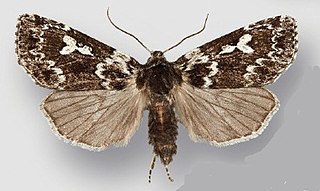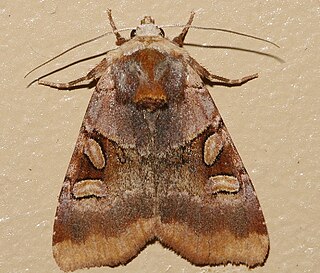
The setaceous Hebrew character is a moth of the family Noctuidae. The species was first described by Carl Linnaeus in his 1758 10th edition of Systema Naturae. It is found in the Palearctic realm. It is a common species throughout Europe and North Asia and Central Asia, South Asia, China, Japan and Korea. It is also found in North America, from coast to coast across Canada and the northern United States to western Alaska. It occurs in the Rocky Mountains from Montana to southern Arizona and New Mexico. In the east, it ranges from Maine to North Carolina. It has recently been recorded in Tennessee.

The square-spot rustic is a moth of the family Noctuidae. It is found in Europe, North Africa and east across the Palearctic and in North America.

Holbrookia maculata, commonly known as the lesser earless lizard, is a species of lizard in the family Phrynosomatidae. The species is native to the southwestern and central United States and northern Mexico. There are eight recognized subspecies.

The rusty-spotted genet, also called panther genet and large-spotted genet, is a genet that is widely distributed in sub-Saharan Africa. It is considered common and therefore listed as Least Concern on the IUCN Red List.

Xestia is a genus of noctuid moths. They are the type genus of the tribe Xestiini in subfamily Noctuinae, though some authors merge this tribe with the Noctuini. Species in this genus are commonly known as "clays", "darts" or "rustics", but such names are commonplace among Noctuidae. Xestia moths have a wide distribution, though they most prominently occur in the Holarctic.

Xestia baja, the dotted clay, is a species of moth of the family Noctuidae. It is found in Europe, Turkey, northern Iran, Transcaucasia, the Caucasus, central Asia, Siberia, Mongolia, Tibet, China, Korea and Japan.
Perinaenia is a monotypic moth genus of the family Erebidae erected by Arthur Gardiner Butler in 1878. Its only species, Perinaenia accipiter, was first described by Felder in 1874. It is here provisionally treated as separate from Xestia, though it seems closely related. Its closest living relatives are not resolved and thus the genus' eventual fate depends on how Xestia is treated.
Xestia elimata, the southern variable dart or variable climbing caterpillar, is a moth of the family Noctuidae. The species was first described by Achille Guenée in 1852. It is found in the eastern part of North America, including Georgia, Tennessee, North Carolina, New Jersey, Maryland and New England.

Xestia badicollis, the northern variable dart, northern conifer dart or white pine cutworm when referring to the larval stage, is a moth of the family Noctuidae. The species was first described by Augustus Radcliffe Grote in 1873. It is found in North America from Nova Scotia to North Carolina, west to Missouri and Ontario.

Xestia stigmatica, the square-spotted clay, is a moth of the family Noctuidae. It is found in most of Europe, Transcaucasia, Caucasus, Kazakhstan, northern Turkey and northern Iran.

Lophocampa maculata, the Yellow-spotted tussock moth, mottled tiger or spotted halisidota, is a moth of the family Erebidae and the tribe Arctiini, the tiger moths. The species was first described by Thaddeus William Harris in 1841. It is found across Canada, the western parts of the United States, south in the Appalachians to South Carolina and Kentucky. They are also found in Southeastern Alaska.

Xestia dilucida, the dull reddish dart or reddish heath dart, is a moth of the family Noctuidae. The species was first described by Herbert Knowles Morrison in 1875. It is found in the United States from southern Maine to northern Florida, west to central Ohio and eastern Texas.
Xestia normaniana, or Norman's dart, is a moth of the family Noctuidae. The species was first described by Augustus Radcliffe Grote in 1874. It is found in North America from Nova Scotia across southern and central Canada to Alberta. In the eastern United States it ranges from Maine to eastern Minnesota, and south along the Appalachians to western North Carolina. It has recently been recorded from Tennessee.

Xestia perquiritata, the boomerang dart, is a moth of the family Noctuidae. The species was first described by Herbert Knowles Morrison in 1874. It is found across North America from Newfoundland, Labrador and northern New England, west to central Yukon, British Columbia and Washington. There are several disjunct populations, including one in the Great Smoky Mountains National Park and the Rocky Mountains in Colorado and a coastal bog in central Oregon.

Xestia smithii, or Smith's dart, is a moth of the family Noctuidae. The species was first described by Pieter Cornelius Tobias Snellen in 1896. It is found across northern North America.

Xestia speciosa is a moth of the family Noctuidae. It is found in northern Europe, including Fennoscandia, the Baltic region, parts of Russia, north Asia, the Pacific Ocean and Japan. It is also found in the mountainous areas of central and southern Europe and north-western North America.

Xestia wockei is a moth of the family Noctuidae. It is known from Siberia and northern North America, including Quebec, Newfoundland and Labrador, the Northwest Territories and Yukon.
X. maculata may refer to:

Xestia tecta is a moth of the family Noctuidae. In Europe the species is only known from the boreal area of Fennoscandia, north-western Russia and the northern Ural Mountains. Outside Europe it occurs in northern and central Siberia and the north-western USA including Alaska as well as north-western and central Canada.

Xestia oblata, known generally as the rosy dart or ruby dart, is a species of cutworm or dart moth in the family Noctuidae. It is found in North America.
















